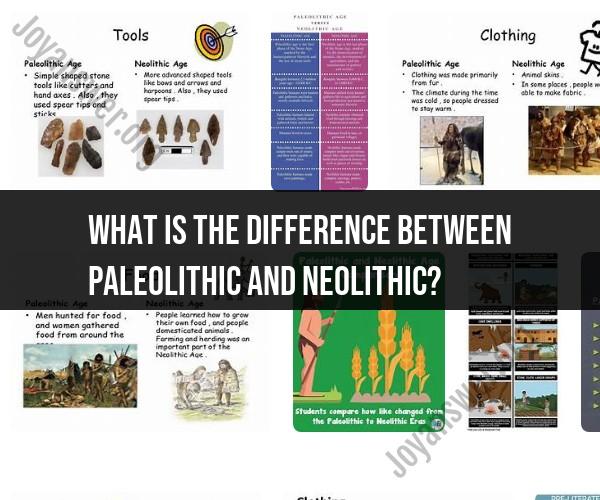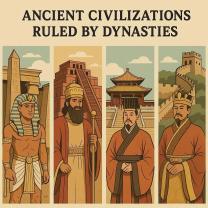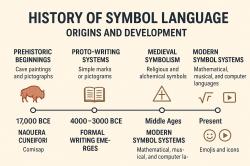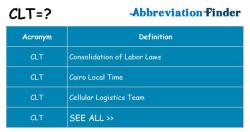What is the difference between Paleolithic and Neolithic?
The Paleolithic and Neolithic periods are two distinct stages in human prehistory, each marked by significant differences in technology, lifestyle, and cultural developments. Here are the key differences between the Paleolithic and Neolithic periods:
Paleolithic Period (Old Stone Age):
Time Frame: The Paleolithic period is the earlier of the two, spanning from approximately 2.5 million years ago to around 10,000 years ago. It covers a vast stretch of time.
Technology: Paleolithic people primarily used stone tools and weapons, hence the name "Old Stone Age." These tools were often simple, chipped from rocks and stones. Tools were mainly used for hunting and gathering.
Lifestyle: Paleolithic societies were hunter-gatherer communities. They relied on hunting animals, fishing, and gathering wild plants and fruits for their food supply. They were nomadic, constantly moving to follow food sources.
Shelter: Paleolithic people lived in temporary shelters, such as caves, rock overhangs, and simple huts made from animal skins or plant materials. These structures were not permanent.
Social Organization: Social groups in the Paleolithic were small and kin-based, focused on survival and cooperation. There was a division of labor, with men primarily responsible for hunting and women for gathering.
Art and Culture: Paleolithic people created some of the earliest known forms of art, including cave paintings and sculptures. These artistic expressions are often associated with religious or ritual significance.
Neolithic Period (New Stone Age):
Time Frame: The Neolithic period followed the Paleolithic and began around 10,000 years ago, marking the transition to settled agriculture and the development of more complex societies.
Technology: Neolithic people developed more advanced tools, including polished stone implements like grinding stones and sickles for agriculture. Pottery and woven textiles also emerged during this period.
Lifestyle: The most significant shift in the Neolithic was the development of agriculture and domestication of plants and animals. People started farming crops like wheat, barley, and rice and raising livestock, leading to more stable food sources.
Shelter: Neolithic communities built permanent settlements, including mudbrick houses and villages. These settlements were often located near fertile land for farming.
Social Organization: With the advent of agriculture, populations grew, and complex societies developed. Surpluses of food allowed for specialization in crafts, trade, and the emergence of social hierarchies.
Art and Culture: Neolithic cultures produced more elaborate pottery and often decorated their ceramics with intricate designs. Architectural advancements and religious monuments, such as stone circles and megaliths, also became prominent.
Burial Practices: Neolithic societies introduced more elaborate burial practices, including the construction of burial mounds and tombs.
In summary, the key differences between the Paleolithic and Neolithic periods are marked by advancements in technology, a shift from hunting and gathering to agriculture and settled communities, changes in social organization, and developments in art, culture, and architecture. The Neolithic period laid the foundation for the development of early civilizations.
Contrasting Paleolithic and Neolithic Lifestyles
The Paleolithic and Neolithic eras are two distinct periods in human history, each with its own unique lifestyle. The Paleolithic era, also known as the Old Stone Age, lasted from approximately 2.5 million years ago to 10,000 years ago. The Neolithic era, also known as the New Stone Age, began around 10,000 years ago and ended between 4500 and 2000 BC in various parts of the world.
Paleolithic Lifestyle
Paleolithic humans were hunter-gatherers. They lived in small nomadic groups and moved from place to place in search of food and water. They used simple stone tools to hunt and gather food, and they made their clothes and shelter from natural materials.
Neolithic Lifestyle
Neolithic humans were farmers and herders. They lived in larger, more settled communities. They developed agriculture and domesticated animals, which allowed them to produce a more reliable food supply. They also built more permanent homes and developed more complex tools and technologies.
Paleolithic vs. Neolithic: A Comparative Analysis
Here is a comparative analysis of the Paleolithic and Neolithic lifestyles:
| Characteristic | Paleolithic | Neolithic |
|---|---|---|
| Subsistence | Hunter-gatherers | Farmers and herders |
| Settlement | Nomadic | Settled |
| Technology | Simple stone tools | More complex tools and technologies |
| Food production | Gathered food from the wild | Produced food through agriculture and herding |
| Social structure | Small, nomadic groups | Larger, more settled communities |
Transitioning from Paleolithic to Neolithic: Key Differences
The transition from the Paleolithic to the Neolithic era was a major turning point in human history. It marked the shift from a hunter-gatherer lifestyle to a farming and herding lifestyle. This shift had a profound impact on all aspects of human society, including technology, food production, social structure, and religion.
Here are some of the key differences between the Paleolithic and Neolithic eras:
- Technology: Neolithic humans developed more complex tools and technologies than Paleolithic humans. This included tools for agriculture and herding, as well as tools for building more permanent homes and making pottery.
- Food production: Paleolithic humans gathered food from the wild, while Neolithic humans produced food through agriculture and herding. This shift to food production allowed Neolithic humans to produce a more reliable food supply and to support larger populations.
- Social structure: Paleolithic humans lived in small, nomadic groups. Neolithic humans lived in larger, more settled communities. This shift to larger settlements led to the development of more complex social structures, such as hierarchies and social classes.
The transition from the Paleolithic to the Neolithic era was a gradual process that took place over thousands of years. It was driven by a number of factors, including climate change, population growth, and technological innovation. The Neolithic era marked a major turning point in human history, and its legacy continues to shape the world today.












